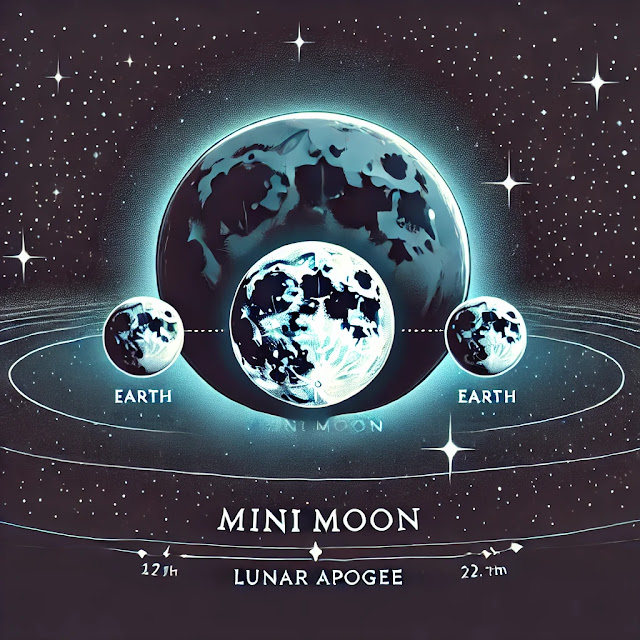Mini Moon: What It Is and When It Will Start in 2024
The Mini Moon is a fascinating lunar event that occurs when the Moon is at its farthest point from Earth in its orbit, also known as apogee. During this time, the Moon appears smaller and dimmer in the night sky compared to its usual size, hence the term Mini Moon. While it might not be as striking as a supermoon, it still offers an interesting shift in our lunar experience.
In 2024, the Mini Moon will be visible for an extended period of 56 days, starting from October 20th. Let’s dive into the details of this event and what makes it special.
What is a Mini Moon?
A Mini Moon occurs when the Moon is at apogee, the point in its elliptical orbit that places it farthest from Earth. On average, the Moon is about 384,400 kilometers (238,855 miles) away from Earth, but during apogee, this distance can increase by as much as 50,000 kilometers (31,000 miles).
When this happens:
- The Moon appears 14% smaller than a typical full moon.
- Its brightness diminishes, making it around 30% dimmer than a full moon at perigee (when the Moon is closest to Earth).
This smaller and slightly dimmer version of the Moon is what we call a Mini Moon. Unlike a supermoon, which draws a lot of attention due to its larger-than-life appearance, the Mini Moon is a subtler event, but still captivating for astronomy enthusiasts.
When Will the Mini Moon Start in 2024?
In 2024, the Mini Moon will begin on October 20th and will last for a period of 56 days. The peak of the Mini Moon event, when the Moon is at its farthest point from Earth, will be on November 17th, 2024.
This period extends through several lunar phases, so you’ll have multiple opportunities to observe the Mini Moon as it moves through its full moon, gibbous, and crescent phases.
Why Does the Mini Moon Last for 56 Days?
Typically, the Mini Moon is considered a single event, lasting a day or two when the Moon is at its farthest point. However, for 2024, this event will span 56 days due to a unique combination of the Moon’s elliptical orbit and Earth’s position relative to the Sun.
This extended period means that the Moon will consistently be farther from Earth than usual for nearly two months, offering a prolonged opportunity to observe its smaller, dimmer appearance.
How to Watch the Mini Moon
Observing the Mini Moon is a simple and rewarding experience. Here are a few tips to get the best view of this unique lunar event:
Use the Naked Eye: You don’t need special equipment to observe the Mini Moon. Simply look up at the sky during the night, especially during the peak on November 17th.
Compare with Past Full Moons: The easiest way to appreciate the Mini Moon is to compare its size and brightness to past full moons, especially if you remember seeing a supermoon earlier in the year.
Telescope or Binoculars: Although the Mini Moon is smaller and dimmer, using binoculars or a telescope can still provide stunning details of the lunar surface.
Photography: Capture the Mini Moon by using a camera with manual settings to adjust for the reduced brightness. Use a tripod to ensure clear shots.
Scientific Significance of the Mini Moon
While the Mini Moon might not be as immediately eye-catching as other astronomical events, it provides important insight into the dynamics of the Moon’s orbit. The fact that the Moon's distance from Earth varies so much throughout the year is a reminder of the complex gravitational forces at play between the Earth, Moon, and Sun.
For scientists and astronomers, the Mini Moon helps in studying the lunar cycle, gravitational effects, and even tides. When the Moon is farther away, the gravitational pull it exerts on Earth's oceans is slightly weaker, leading to minimal changes in tidal behavior.
Mini Moon and Astrology
For those who follow astrology, the Mini Moon is seen as a time of introspection and subtle change. In contrast to the supermoon, which is associated with powerful emotions and heightened energy, the Mini Moon represents a time to slow down, reflect, and let go of anything that no longer serves you. This is particularly true during its peak on November 17th, when the Moon will be in Taurus, a sign known for grounding and stability.
Conclusion
The Mini Moon event, starting on October 20th, 2024, offers a unique opportunity to observe the Moon at its farthest point from Earth for an extended period of 56 days. Although the Mini Moon doesn’t have the dramatic appeal of a supermoon, it’s a subtle yet fascinating astronomical occurrence that highlights the delicate balance of celestial movements.
So, mark your calendars for October 20th and enjoy this extended period of observing the Mini Moon as it travels across the night sky, smaller and dimmer than usual, but no less captivating.
Discover the Mini Moon, a unique lunar event lasting 56 days in 2024, starting from October 20th. Learn what makes the Mini Moon special and how to observe it.






